All posts by Bryan Kavanagh
Learning the lessons of history?
 LOOK TO HISTORY TO SEE OUR FUTURE
LOOK TO HISTORY TO SEE OUR FUTURE
ALAN Kohler’s Theatre of the Absurd in today’s Business Spectator is worth the read. While politicians around the world are congratulating themselves on their stimulus packages, they’ve not put anything in place that’s going to stop financial collapses from happening in future! That’s been a problem for a long time now. Maybe they’re too scared to offend powerful landed interests who ‘cruel the pitch’ for the rest of us?
Maybe we need to sack weak-kneed neo-classical economists and put scientists on the case? They’d soon understand the implications of P – R = W + I. They wouldn’t bury it, or turn absurdly ad hominem against Henry George.
People understood the principle centuries before Henry George came on the scene. They’d seen the collapse of Ancients Rome and Greece due to taxation and land speculation and, under the inspiration of William the Conqueror, tried something else.
Professor Thorold Rogers says they eventually got it working pretty well, too:-
“I have stated more than once that the fifteenth century and the first quarter of the sixteenth were the golden age of the English labourer, if we are to interpret the wages which he earned by the cost of the necessaries of life. At no time were wages, relatively speaking, so high, and at no time was food so cheap. Attempts were constantly made to reduce these wages by Act of Parliament, the legislature insisting that the Statute of Labourers should be kept.
But these efforts were futile; the rate keep steadily high, and finally becomes customary, and was recognized by Parliament.
It is possible, that as the distribution of land became more general, and the tenancy of land for terms of years became habitual, the phenomenon which has often been noted as characteristic of peasant proprietorship, a high rate of wages paid to free labour, may have been exhibited in the period on which I am commenting. …..
[Rogers goes on to provide the daily wage of artisans, agricultural labourers, skilled craftsmen, carpenters, plumbers and joiners.] ….
Nor, as I have already observed, were the hours long. It is plain the day was one of eight hours.”
Six Centuries of Work and Wages – The History of English Labour, James E. Thorold Rogers, T. Fisher Unwin, 12th edition, London, 1912, pp. 326-327.
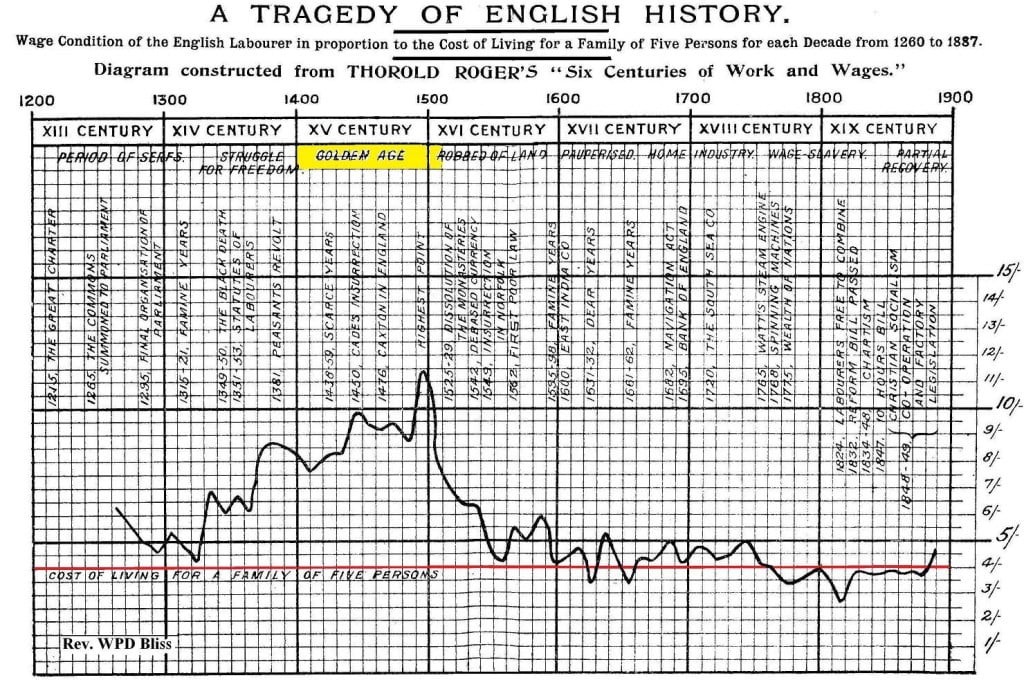
It’s too sweeping and glib to ascribe the peak in the above chart by the Reverend WPD Bliss (constructed from Thorold Rogers’ painstaking examination of Manor Rolls over six centuries) to the labour shortage resulting from the Black Death. This would sell Rogers short as an economic historian. The Black Death peaked in 1350 and this accounts for the large uptick appearing in the latter half of the fourteenth century.
So, when land rent was collected and there were few taxes, workers were actually more prosperous than they are today! And they were debt free!
Maybe this key aspect of feudalism still carries an important lesson for our current brigade of smug and self-congratulatory ‘ploticians’ and ‘conomists’? The chart below demonstrates that under their policy-making, we continue to have the sort of retrogressions shown in Bliss’ graph.
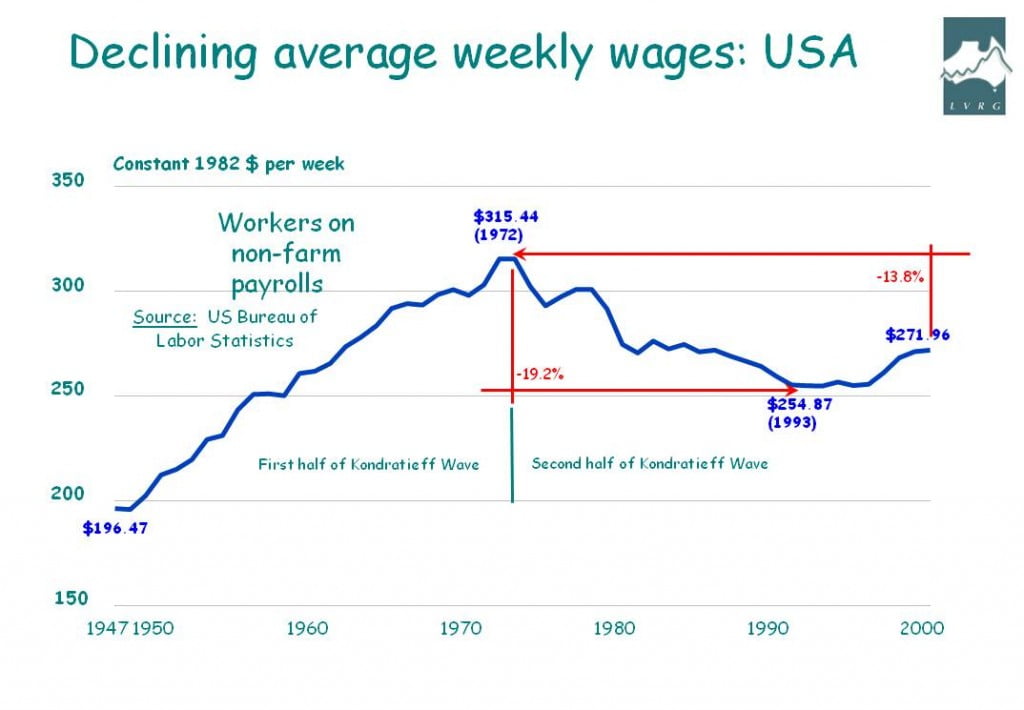
STOCK MARKETS AINT MY BAG!

I admit to not understanding the niceties of stock markets. At times this has been a source of frustration to my friend, Phil Anderson, whose knowledge of its workings are unparalleled.
I’ve struggled to ingest the detail as Phil has patiently explained some technical aspect or other of the ASX to me. His subscribers obviously derive great value from Phil’s incredible share market skills.
Still, my more real estate-oriented mind does occasionally seize upon certain of his insights; such as that the share market has already factored real estate market happenings into its prices well before the real estate market itself will. And I’m sure that’s usually correct, because that was the sequence of events when the US ‘subprime crisis’ hit. Although share market prices dived, residential real estate was first characterised by a drop in turnover before, after a short delay, prices reacted.
At least in the low to middle ranges of the Australian real estate market, we are currently in a somewhat longer hiatus between a fall in turnover and the price drop. The more limited, prestigious end of market has already experienced price declines at several top addresses, and margin calls against highly-leveraged property will account for more than a handful of these.
Similarly, my investigations into real estate sales in the early to mid 1920s in Australia and the US led me to conclude that it was not the 1929 United States stock market collapse that brought about the Great Depression, but rather the real estate boom that had preceded it. This isn’t widely understood, because it was October 1929 that grabbed all the headlines.
Phil Anderson’s excellent new book “The Secret Life of Real Estate” confirms this thesis. His foray into real estate cycles in the US over the last two centuries had me sitting up and paying attention, so I can recommend a read of “Secret Life” for anyone wishing to lay bare the workings of the real estate market and to understand how it impacts both upon the share market and the economy. Phil’s research into US real estate market cycles is painstaking, illuminating and enjoyable. I wonder whether you would differ from my layman’s approach to the following, Phil?
Last week I came across this “Chart of the Day” measuring the US stock market in terms of the S&P 500 price to earnings ratio. The recent spike leapt off the screen at me. It suggests that the P/E got as high as 144 in what I have assumed to be the recent ‘dead cat bounce’. The text accompanying the chart says that it still stood at 129 at the end of the June quarter. The poor profits reporting season obviously played a large part in these incredibly high ratios. By comparison Australian P/Es are far more modest as they struggle to break the 20 barrier.
If the “Chart of the Day” is accurate, it has similarity to the sub-3% yields experienced in the Australian residential market over recent years. Most people know that for the sake of commercial reality these anomalies must ‘correct’ back towards the long term mean – and if it happened to be 8 years after S11, or 80 years after the 1920s crash, I guess there’d be some sort of symmetry.
Stirring times!
MASON GAFFNEY

MASON GAFFNEY
Like a beacon, Mason Gaffney has stood for decades above the ruck of world economists, because he dared to express a great truth that offends views held by his profession.
As the world slips into a new economic depression, here are three distinct, but interlinked, examples of Gaffney’s work:-
- 1) Insights into the purposeful corruption of economics at the outset of the 20th century which set in stone periods of recession and depression.
- 2) The manner in which this corruption destroys capital, with Michigan (and California) examples.
- 3) “The Four Vampires of Capital” – an explanation of to where capital disappears (pages 12-17 in the latest “Land & Liberty”).*
The bonus that comes with reading Gaffney’s insightful papers is a brilliant turn of phrase, honed presumably during his time as a journalist with TIME magazine:-
*”There were two leading charlatans: Arthur Laffer Jr and Robert Barro. Laffer drew his famous curve on Dick Cheney’s cocktail napkin in 1974 and changed the course of history ……… Our ‘new’ President Obama has not radically changed the tenor of his economic advisors. Dick Cheney the person has been relegated to Darth Vader emeritus, but the malady lingers on.”
[Don’t miss Mason Gaffney’s new book, “After the Crash”!]
WE’RE LAUNCHED! (Yes, today – but see earlier posts)
THE DEPRESSION blogsite is up and running today – 26 August 2009!
I’ve included earlier posts sent by e-mail to all of Australia’s federal politicians on the dates shown. Some of these have been amended.
I thank Karl Williams (K1) and Karl Fitzgerald (K2), recently-retired editor of “PROGRESS” and Prosper Australia’s webmaster, respectively, for having published some of these thoughts.
Additional to the blog are separate pages relating to a forecast I made in 2001, a 2007 report showing the influence of the tax system on Australian real estate bubbles, and five published newspaper articles.
So, it’s all ‘go’!
MANY LOCAL CRISES ADD UP TO ONE ‘GLOBAL’ FINANCIAL CRISIS! (Originally Mon 25 May 2009)
IT WAS LOCAL BEFORE IT WENT GLOBAL – AND WHERE WERE THE RISK MANAGERS AND ANALYSTS?
It’s an understatement to say that the US rating agencies’ sins of omission proved to be costly. They’d been given respect they didn’t deserve, so economists and policy makers were blindsided to the financial collapse that has settled across America.
The agencies failed to get their heads around the central fact that so obviously mocks them now; that the real estate bubble on which much US debt was leveraged didn’t represent real wealth at all. It was a chimera. That treasuries and central banks also missed the point clearly indicts the study of economics. Something is horribly amiss!
The same mindset that levied counterproductive taxes on industry yet gave benefits to negatively geared properties, in addition to depreciation allowances, also tended to hide the reality of the real estate bubble.
We’ve designed tax systems to mollify incredibly selfish landed interests, but it’s only at the bursting of real estate bubbles that the complicity of revenue regimes becomes exposed. Incredibly, even at these times most analysis becomes diverted from recognising that pathological tax regimes are directly responsible for the creation of recession and depression: and so we repeat them, again and again.
Given that the economy leverages off and is directed by real estate, there’s also a stunning absence of analysis of the Australian real estate market by federal government authorities. Privately-held real estate sales data is purposefully misinterpreted by the real estate industry to spread self-serving disinformation. Christopher Joye of RP Data-Rismark goes so far as to say that Australia has experienced no real estate bubble at all. The RP Data-Rismark National Dwelling Value Index which rose by 1.6% in the first quarter of 2009 is used to validate the point.
Haven’t other economic experts reassured us also that Australian banks have been more circumspect in their lending practises than the US, anyway, so any recession we have can’t be as bad? They certainly have, but these are the same people who failed to see the recession coming, and they continue to accept, even disseminate, false information about the extent of our real estate bubble.
THE MISSING DETAILS
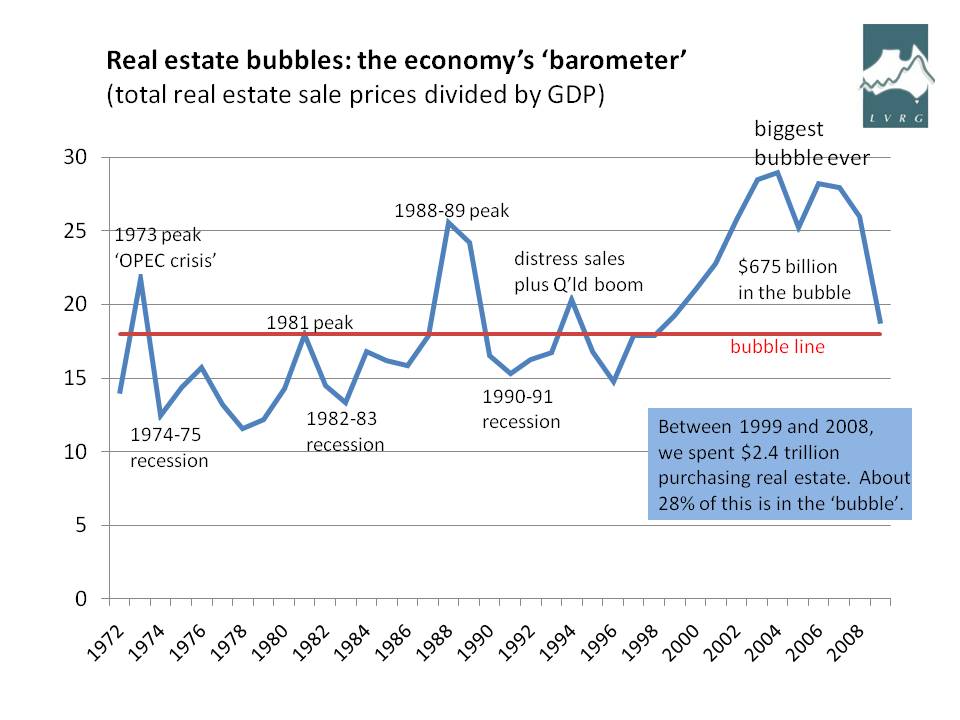
The chart displays the overpowering size of Australia’s recent real estate bubble against GDP. During the period of the bubble, from 1999 and 2008, we spent $2.4 trillion in real estate transactions. Of that amount the $675 billion above the ‘bubble line’, will need to be liquidated. In terms of a $1.1 trillion dollar economy, it may be seen that a write-down of $675 billion portends an enormous meltdown of the Australian financial system; one to which our big four banks are exposed in extremis.
The University of Western Sydney’s dogged and brilliant associate professor Steve Keen has replicated a ‘Long Term Real House Price Index’ for Australia similar to the US Case-Shiller Index, linking house prices to consumer prices from the late 19th century. It suggests the Australian index has actually peaked at some 1.7 times the US index!
This acts to highlight the extraordinary disinformation spread about by real estate industry bubble-deniers. We’re not simply experiencing collateral damage from the bursting of the US residential property bubble, as claimed by federal politicians and exoneration-seeking economists within the RBA and Treasury, but have inflated our very own real-estate bubble that dwarfs that of the US in relative terms.
It is becoming clearer by the day that the only other difference between the US and Australian bubbles is the timing of their bursting. That the relatively larger Australian bubble extended as long as it did in comparison with the US and UK was mainly because of Queensland and Western Australia’s booming mineral sales; but that has slowed for now.
The latest RP Data-Rismark real estate commentary is mysteriously silent about Australian real estate sales turnover falling 30% over the second half of calendar year 2008. This bursting of the Australian bubble was reported in April on “Crikey” and the ABC’s “Lateline Business” by Gavin Putland, director of the Land Values Research Group. The First Home Owners’ Boost, the Australian government’s very own version of US subprime loans, has inflated the lower end of the residential property market and helps explain the 1.6% uptick in prices so far this year.
But as the economic downturn deepens, people will have to say goodbye to forlorn hopes of obtaining a better price for the properties they need to sell in a stronger ‘late-2009 recovery’. So, just as happened in the US, the superheated Australian real estate market will become glutted with unsold properties.
We’re at the turning point of the nefarious boom-bust cycle. The chart below demonstrates that our land prices have a long way to drop before they approach their historical average relationship of 1.1 times GDP. If they don’t overshoot on the way down, this will represent an average decline of 60% in site values, or a drop of some 50% in improved real estate values.
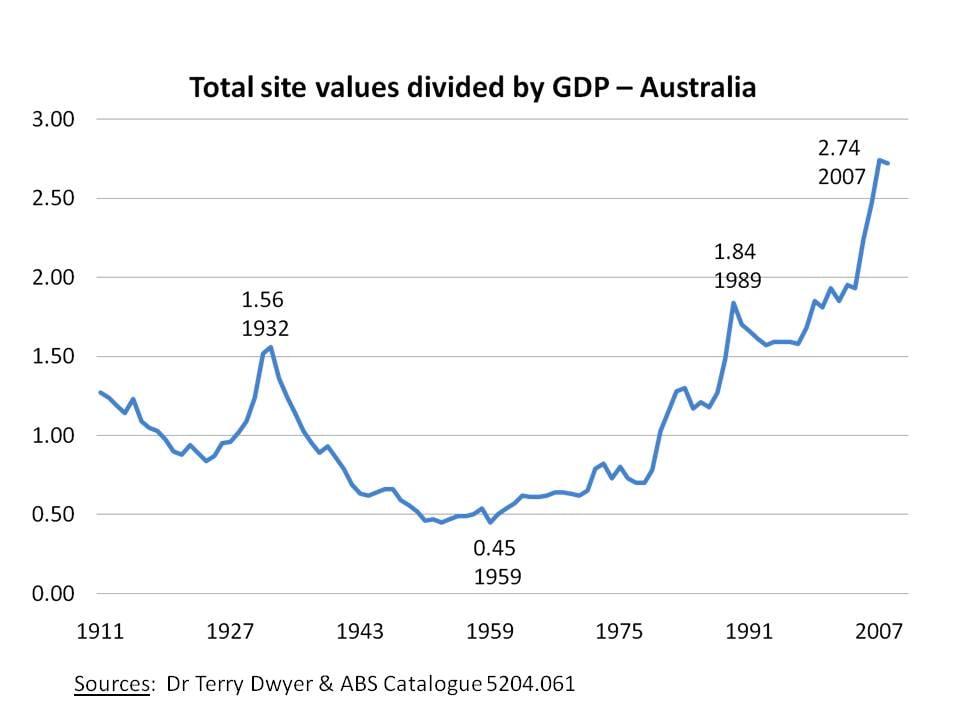
THE FIVE STAGES OF GRIEF
Dealing emotionally with an economic depression may be likened to Elisabeth Kubler-Ross’ five stages through which grief-stricken people pass. We may expect to respectively experience:
- 1 Denial
- 2 Anger
- 3 Bargaining
- 4 Depression, and
- 5 Acceptance.
Due to the lack of official information in connection with real estate, many Australians remain in Stage 1: ‘Nothing has really happened here; some prices are going up; Australia is different.’
Policy makers are faced, however, with an increasing amount of evidence as to “where we’re at” as outcomes from Australia’s speculative real estate excesses are starting to loom large. So that our politicians may avoid the numerous stumbling blocks that are likely to be met at each stage of the process (this might include trying to bail out banks rather than insisting they quickly write down their mortgages to market reality), they need to acknowledge the inevitability of Stage 4, move quickly to ‘Stage 5’, then urgently address the necessary structural revenue reforms.
That our bubble didn’t burst until recently (in terms of turnover, if not price) could be used to our advantage if we want to avoid some of the financial and social distress that has struck the US and Europe. Should we fail to do this, we’ll mindlessly ape their mistakes.
GENUINE TAX REFORM
For Australians to ensure a quick-exit from the economic depression, the Rudd government could not have positioned Ken Henry’s “Australia’s Future Revenue System” (AFTS) more opportunely.
Unfortunately, however, the history of previously sorties into ‘tax reform’ demonstrates that the exercise inevitably degenerates into a simple switching of emphasis between income and sales taxes, hopelessly alternating on each occasion from one back to the other.
There is great risk that AFTS will fall into such sham ‘reform’ again, but, if the Henry inquiry is to encourage confidence and productivity, it is clear that the country desperately needs to slash taxes savagely in favour of greater land value capture – via municipal rates and reformed ‘all-in’, flat rate State land taxes.
“Unlocking the Riches of Oz”, my 2007 study of recurrent real estate bubbles promoted by an errant tax system, demonstrates that greater emphasis on land-based revenues could double Australia’s GDP in short order. The measure also has positive implications for decentralisation, the rejuvenation of our regional areas where land values are cheaper, and for creating a more sustainable economy.
It would be far easier on the national coffers, moreover, than putting future generations of Australians into hock through the sort of costly and questionable government interventions we’ve not only witnessed overseas but also increasingly at home. Freeing up labour and capital from taxation is a major initiative, but the writing on the wall suggests that it needs to be done urgently.
DEPRESSIONS FOR DUMMIES (Originally Fri 27 March 2009)
DEPRESSIONS 101.0
Let’s say labour joins with capital and land to produce wealth, and that the locational rent of land arises as a by-product, simply from the existence of the surrounding community and its infrastructure.
Say, for some reason or other, you wanted to create an economic depression. How would you go about doing it? OK, let’s tax labour and capital to reduce their wages and profits, respectively. But don’t collect the publicly-generated land rent for government – because we’re trying to get a depression happening, remember?
So you fine labour and capital for working, but you don’t capture the land rent, is that it? Yes, but that’s only the beginning. It’s what happens next with the publicly-generated rent you’ve left in private hands that’s the most important consideration. That’s because if you’re really trying to create economic depression, you’ve got to set up a vast disparity in wealth, and to squeeze the middle class and the poor. You choke off demand by putting them into such debt that it can’t be repaid.
Now, as super-wealthy people own much more valuable property, sometimes mineral and spectrum licenses, they also control much more of the nation’s economic rent. That means that every red cent they pay in taxation is clawed back by the increases in land rent which is then capitalised back into the value of their land and natural resources. They may pay more tax than the poor, but they’ll certainly be able recoup far more than that amount via their escalating land values. By fully privatising the economic rent of their land, mining and spectrum rights, they simply continue to translate that value into the value of ‘their’ assets.
But renters can’t do this, because they get no land rent. See? They actually pay the land rent to their landlords. They also pay taxation, so they’re whacked doubly. Similarly, the owners of only one home have control of relatively little land rent, so they can’t claw back much of their taxation. Yet, curiously, they often side with the 0.1% for the following reasons.
What will homeowners, maybe even some renters, try to do? The middle class will look at what’s happening, and realise that they need to get off this taxpaying treadmill and become asset rich, too. They must become landlords. So they invest in properties on which they will not only get the rent for the improvements, but the rent of land that goes uncollected by government. Not only that, but if they can ‘negatively gear’ their properties, such that the income they receive is less than the interest they’ll pay, the tax system will help them buy these properties! What does it matter if they get deeply into debt? Ever-increasing asset values will fix that. Er, it will … won’t it?
Enter the FIRE sector of the economy, this is, finance, insurance and real estate. It doesn’t create wealth, it diverts it away from the public by privately capturing the land rent as mortgagee. Whilst this segment can sometimes serve the productive side of the economy, it actually prefers to serve the destructive side, to create recession or economic depression. In the latter mode, it becomes a parasite. Not only does it take over its host’s body, but it sinks probes deeply into its brain, to control the brain, convincing itself that the FIRE sector is the most important part of the economy*, and that the property speculator plays an heroic part. Just listen to rent-seeking banks bleat about their own importance! Why, they’re providing housing accommodation aren’t they? [* Metaphor, courtesy of Michael Hudson.]
So, now that we have everyone but the poor engaged in pumping up real estate and sending productive industry offshore to where land prices, taxation and labour are all much lower, the depression is now well under way. We simply wait for the property bubble to burst. The ship, as they say, must hit the span.
The final tool in our kit is the politician. People will look to him to remedy the depression – but we have this one covered, too. Being an ‘investor’ himself, he has come under the spell of the FIRE parasite and is busy singing its praise. For the sake of keeping personalities out of things, let’s call him, Barack Cameron. We must bail out the FIRE sector, proclaims Barack to his fellows. The Great Recession is only a temporary phenomenon! In fact, we must do everything we can to look after the FIRE sector, because it is much more important than people or the economy! We must not, repeat not under any circumstances, free up labour and capital by far greater capture of our economic rents to get the economy back to work! What sort of idiot would want to suggest that?
Is this is a fairy story? Economic depressions can’t possibly happen this way? If they did, they could surely be cured simply by switching the revenue source from taxes to rents? It can’t be right, because professors of economics and the media constantly advise “there are no simple solutions, no silver bullets” …. ?
______________________________________________________________________
GLOSSARY OF USEFUL TERMS IN A DEFLATION
Ploticians – members of political parties who plot against the interests of the people, choosing rather to serve the interests of the party, landlords and other real estate lobbyists, instead of their constituents.
Conomists – conmen and women who work with ploticians to convince people that labour and capital have opposing interests, and who okay taxing the earned incomes of both – instead of untaxing them and capturing publicly-generated site rents for necessary revenue.
Landlords – the real lords of the land (90% of those in Business Review Weekly’s “Rich 200” list, forget that 26% found in Wiki!) who have maximized the great privileges granted under the tax system to help pay for their real estate purchases at other people’s expense – then claw back every red cent of the taxes they’ve ever paid, per medium of increases in the value of their real estate ‘assets’.
TenANTS – people deemed to be insignificant little insects who are unable to claw back all their taxation through uplifts in their land values, as landlords do.
Middle Class – those who aspire to become landlords so they, too, can claw back their taxes, but get it in the neck at each and every economic downturn. (Not to be confused with the real landlords in BRW’s “Rich 200” list!)
Voters – those who don’t seem to regret subjugating their interests to those of ploticians, conomists and landlords.
Democracy – the system in which all the abovementioned pathologies are rolled together and permitted to create economic recessions and depressions at regular intervals.
Tax Reform – the unthinking alternation of emphasis between (A) taxes on incomes and (B) taxes on purchases. These are usually accompanied by the winding back of land-based revenues.
WHOSO WOULD BE A MAN MUST BE A NONCONFORMIST – Emerson (Originally Thurs 5 March 2009)
Something happens when like-minded people get together in groups. Their IQs halve. If the most obvious fact put by an outsider challenges the group’s mindset, the interloper should be set upon and duly removed by the group’s designated attack dogs. The status quo must be preserved.
LEAVING THE ‘CON’ IN ‘CONFIDENCE’
No matter what happened that brought about this economic downturn, economists certainly weren’t to blame. How could they have been? Nobody could possibly have foreseen this coming.
The one or two blowhards, such as Steve Keen and Bryan Kavanagh, who ‘foresaw’ household debt and real estate prices levels to be ‘impossible’ are only publicity-seekers. What were they trying to do? Destroy confidence in the economy? They ought to know that a mountain of debt is a house of cards that will collapse if anyone does the wrong thing!
Access Economics has played a more respectable part throughout. Chris Richardson patiently and simply says nice things about the economy. There’s no harm him talking possible recession once everybody’s onto that possibility. And that’s the way it has to be if people are to maintain their confidence in finance, insurance and real estate – sometimes called the ‘FIRE’ sector.
We can let economists take a shot at the percentage increase in next year’s GDP, or the overnight cash rate that might apply this time next year, but that’s just a nice guessing game. However, anyone who claims to see dark clouds on the economic horizon must be called exactly what they are: imposters; fraudsters.

The two major political parties stand as models. They may seem to be at odds as they cut each other to shreds, but they still honour group rules. Neither major party will support any major economic ‘reform’ because that will only give the other side leverage for criticism – and that will scare the horses!
There’s no good reason it shouldn’t be a common tactic to accuse the other side of putting the wind up people. Clearly, much of society is too fragile to have truth thrust upon them, so placatory and reassuring statements about preserving the economic status quo must be the order of the day!
That doesn’t mean that politicians can’t try to sound smart. George W Bush Republicans who governed during the build-up of the subprime crisis and oversaw CDOs and CDSs sweeping across the financial landscape are now gifted to see exactly where Barack Obama is making his mistakes.
Similarly, Malcolm Turnbull has been endowed with clever economic insights apparently unavailable to Peter Costello as he presided over developing Australia’s real estate bubble. Rudd’s throwing cash at people provides no lasting legacy, opines Turnbull. People aren’t spending it, they’re simply saving it, or paying off mortgages, says he. To think that economists once believed that savings equated to investment, and investment was once highly regarded! And no, of course people shouldn’t try to pay off their mortgages, Malcolm!
It’s right that Kevin Rudd and Wayne Swan don’t accuse Peter Costello of failing to deal with the residential real estate bubble he allowed to develop from 2000, because they (quite correctly) also turned a blind eye to so-called ‘rampant’ residential investment. You should never interfere with happenings in the real estate market!
Politicians are only our representatives, anyhow; they’re not trained professional Treasury economists, and Treasury and the RBA certiantly won’t advise them to abolish real estate bubbles! Clearly, it’s the job of politicians to look and sound extremely busy and concerned as they flit overseas seeking ‘global solutions’.
Our shock jocks on the radio also have an important part to play in seeing that the economy stays pretty well the way it is. Let them scare people witless about any proposed change. That’s what keeping the economy as it is and retaining confidence is all about, isn’t it?
Some clowns even suggest we can fix the GFC locally by reversing the process that brought it about, by a tax switch from people for working to revenues from land to stop land monopoly and speculation. Monopoly and speculation? One can only hope Ken Henry consigns that one to the WPB!
It’s no good bailing out big business, these people say, if the community hasn’t a dollar to spend on those businesses. And, we should simply allow the unrepayable debt to be written off inside what they say has been a profligate FIRE sector! Profligate?! Finance, insurance and real estate is the heart and soul of the economy, yet these idiots say it’s only a service sector we’ve put on a pedestal! What nonsense!
Then, as we prepare to bail out our major banks, they impudently confront us with: “Why should we bail out banks, instead of focusing on creating effective demand by slashing taxes?” Purveyors of this sort of nonsense used to be tarred and feathered and sent out of town on a rail! Although we’ve do have to support failed major institutions for confidence’s sake, this mustn’t be extended to small business. And don’t fall for the one about most business activity outside the FIRE sector being the real economy!
Crackpot ‘seers’ have gone about as far as they should be allowed to go. It’s quite obvious that manufacturing and real wealth creation has long ago been driven offshore to where there’s tax breaks and cheap land, so who wants to cut taxes and capture land rents here now, anyway? The horse has bolted!
We’ve got to accept that the whole system is now geared to penalise labour and capital and reward property rorts. That’s what we’re good at! So, it’s only an idiot, someone outside the mainstream, who would want to interfere with this set-up! What sort of chaos would that create! Society’s norms are not to be interfered with, because this is what we know and understand.
So, how should governments tweak this minor economic downturn? Why, they should use their economists, of course! Especially those who presided over the downturn, because they’ve been close to what happened. They’re the experts …. they, and their economic models!
[Ah, that’s better! Nothing like a good rant!]
LAND VALUES RESEARCH GROUP CALLS THE AUSTRALIAN BUST! (Originally Tues 3 March 2009)
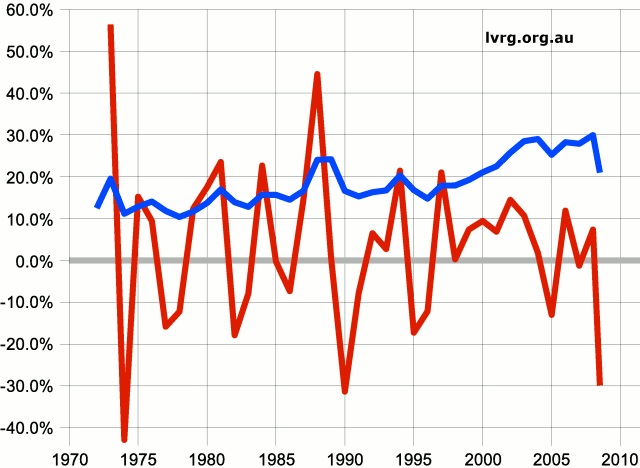
“Crikey” yesterday reported my colleague, Dr Gavin Putland, calling the bursting of Australia’s real estate bubble, based on Kavanagh-Putland Index data. The blue line in the index above represents Australia’s total real estate sales prices divided by GDP. The red line, depicting the annual change in the index, shows a decline of 30%. This is big!
The sharp drop is obviously in real estate turnover rather than a skyrocketing GDP. It doesn’t say much about real estate prices yet. Suffice to note that turnover will always drop before prices, but property analysts, being more seduced by the level of sales prices than turnover will overlook this point.
Gavin explains more about the Kavanagh-Putland Index here.
LOVE TO HEAR HIM SING THIS (Originally Wed 25 Feb 2009)

Blowin’ in the wind
Why must we be fined with tax, for workin’ for the nation?
Yes, ‘n’ how many years will it take before … we’ll quit our occupation?
Why won’t we turn where the tax breaks are … in real ’state speculation?
The answer, my friend, is blowin’ in the wind, the answer is blowin’ in the wind.
How many times can pol’ticians cry tears, ’bout housing ’ford-abil-ity?
If they can tax everything else, but let our land rent go free?
Why let economic rent escape, though it is stup-id-ity?
The answer, my friend, is blowin’ in the wind, the answer is blowin’ in the wind.
How many times can real estate busts bring on social disjoint?
And why is it that ‘conomists keep on missin’ the point?
Yes, ‘n’ how many times must the tax system fail – before we a land rent appoint?
The answer, my friend, is blowin’ in the wind, the answer is blowin’ in the wind.
Why do they bail out all of the banks, when they killed off effective demand?
Henry George showed how to remedy boom ‘n’ bust – what’s to understand?
Let people keep what they have earned, and take the rent of land,
The answer, my friend, is blowin’ in the wind, the answer is blowin’ in the wind.
Britain’s landlords in 1909, killed off “The People’s Budg-et”,
But promoted war in 1914 …. lest – we – forget,
So The Powers That Be’d rather go to war, than the public’s land rent collect?
The answer, my friend, is blowin’ in the wind, the answer is blowin’ in the wind.

